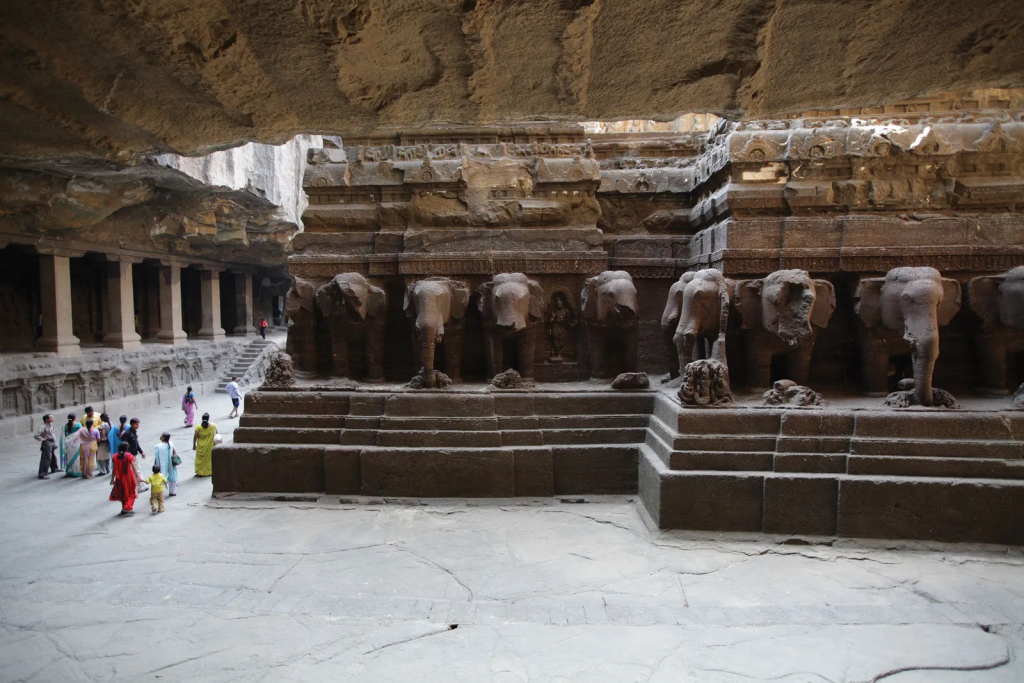Introduction:
India, a land rich in cultural heritage and architectural wonders, is home to an array of breathtaking temples that leave visitors in awe. Among these remarkable structures, the grand rock cut temples stand out as masterpieces of ancient architecture. Carved meticulously into solid rock, these temples showcase the artistic and engineering prowess of their creators. In this blog post, we will delve into the fascinating world of India’s grand rock cut temples and explore their historical significance and architectural splendor.
The Ajanta Caves:
Located in the state of Maharashtra, the Ajanta Caves are a UNESCO World Heritage Site and a testament to India’s ancient artistic brilliance. Carved between the 2nd century BCE and 6th century CE, these 30 caves serve as exquisite rock-cut monasteries and temples. Adorned with intricate murals and sculptures, the Ajanta Caves provide a glimpse into the life of Buddha and the evolution of Buddhist art.

The Ellora Caves:
Situated in the Aurangabad district of Maharashtra, the Ellora Caves are an unparalleled architectural marvel. Spanning a period of over 500 years, from the 6th to the 11th century CE, these caves encompass 34 structures, including Buddhist, Hindu, and Jain temples. The most famous of these is the Kailasa Temple, dedicated to Lord Shiva. Carved out of a single rock, the Kailasa Temple is the largest monolithic structure in the world, showcasing intricate carvings and sculptures that mesmerize visitors.


The Elephanta Caves:
Nestled on the Elephanta Island near Mumbai, the Elephanta Caves are an epitome of Hindu rock-cut architecture. Dating back to the 5th and 8th centuries CE, these caves feature awe-inspiring sculptures dedicated to Lord Shiva. The masterpiece of this site is the Trimurti sculpture, depicting the three faces of Lord Shiva in his roles as the creator, preserver, and destroyer of the universe. With its rich symbolism and intricate craftsmanship, the Elephanta Caves attract visitors from all corners of the world.

The Badami Caves:
Located in the state of Karnataka, the Badami Caves are a remarkable example of early rock-cut architecture in India. Dating back to the 6th century CE, these caves were constructed by the Chalukya dynasty. Carved out of sandstone cliffs, the four caves represent a blend of Hindu, Jain, and Buddhist influences. The intricate carvings and sculptures within the caves depict mythological stories and deities, making them a treasure trove of ancient Indian art.

The Mahabalipuram Monuments:
Situated on the Coromandel Coast of Tamil Nadu, the group of monuments at Mahabalipuram includes several rock-cut temples and sculptures that reflect the architectural brilliance of the Pallava dynasty. The most iconic structure among them is the Shore Temple, which stands as a testimony to the rich cultural heritage of South India. Carved out of granite, the Shore Temple overlooks the Bay of Bengal and is dedicated to Lord Shiva. Its exquisite carvings and elegant proportions make it a UNESCO World Heritage Site.

In addition to the temples mentioned earlier, here are a few more grand rock cut temples in India:
Rani Ki Vav:
Located in Patan, Gujarat, Rani Ki Vav (Queen’s Stepwell) is a magnificent rock-cut stepwell that dates back to the 11th century. It is not a temple in the traditional sense but is an architectural marvel that was primarily used for water storage and as a resting place for travelers. The stepwell is adorned with intricate sculptures and carvings depicting various Hindu deities and mythological scenes.

Udayagiri and Khandagiri Caves:
Situated near Bhubaneswar in Odisha, the Udayagiri and Khandagiri Caves are a group of 33 rock-cut caves that were built during the reign of King Kharavela in the 1st century BCE. These caves were used as residential and meditation chambers by Jain ascetics. The carvings in the caves depict religious motifs, animals, and scenes from daily life.
Masroor Rock Cut Temple:
Located in Kangra Valley, Himachal Pradesh, the Masroor Rock Cut Temple is an intriguing complex of 15 monolithic rock-cut temples. Believed to have been carved around the 8th century, the temples showcase a unique blend of Indo-Aryan and Dravidian architectural styles. The main shrine is dedicated to Lord Shiva, and the intricate carvings depict various gods and goddesses.
Karla Caves:
Situated near Lonavala in Maharashtra, the Karla Caves are ancient rock-cut Buddhist caves dating back to the 2nd century BCE. The main attraction of the site is the grand Chaitya Hall, which features impressive rock-cut architecture and a large stupa. The intricate detailing on the pillars and the beautiful sculptures make Karla Caves a must-visit for history and architecture enthusiasts.
Pancha Rathas:
Located in Mamallapuram (Mahabalipuram), Tamil Nadu, the Pancha Rathas (Five Chariots) are a group of monolithic rock-cut temples that date back to the 7th century. These magnificent structures are named after the Pandavas from the Mahabharata epic and are carved in the shape of chariots. Each ratha represents a different architectural style and is dedicated to a different deity.
These additional rock cut temples further highlight the rich architectural heritage of India and offer visitors an opportunity to witness the extraordinary craftsmanship of the past. Exploring these temples provides a deeper understanding of India’s history, culture, and the artistic excellence achieved by the ancient civilizations.
Conclusion:
India’s grand rock cut temples stand as magnificent testaments to the architectural prowess and artistic brilliance of the ancient civilizations that once thrived in the subcontinent. These structures, carved meticulously out of solid rock, transport visitors to a bygone era and provide insights into the rich cultural heritage of India. From the Ajanta Caves to the Mahabalipuram Monuments, each temple tells a unique story and leaves an indelible impression on all who behold them. Exploring these grand rock cut temples is a journey back in time and a truly awe-inspiring experience.
